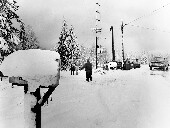
WEDNESDAY, Feb. 2 (HealthDay News) — The huge winter storm producing up to two feet of snow Wednesday in some sections of the United States could also cause a blizzard of injuries if people don’t take proper safety precautions while shoveling or playing in the snow, the American Academy of Orthopaedic Surgeons warns.
“Shoveling snow involves a lot of bending and heavy lifting, particularly in wet, heavy snow. It may be especially vigorous for people who do not regularly exercise, as their back, shoulder and arm muscles may not be prepared for that level of activity,” AAOS spokesman Dr. Michael F. Schafer, an orthopedic surgeon at Northwestern Memorial Hospital in Chicago, said in an academy news release.
When shoveling, you should clear snow early and often; use a shovel that is comfortable for your height and strength; push the snow instead of lifting it; and avoid throwing the snow over your shoulder or to the side, the AAOS advises.
If you’re using a snow blower, never stick your hands in the machine. If snow becomes stuck, stop the engine and wait at least five seconds before using a solid object to clear wet snow or debris from the chute.
Many people will welcome the fresh snow because it means they’ll be able to enjoy outdoor activities such as sledding. The AAOS offers the following sledding safety tips:
- Don’t sled near or on public streets. Sled only in designated and approved areas where there are no obstacles in the sledding path.
- Sit in a forward-facing position and steer using your feet or the rope steering handles.
- Children should wear a helmet while sledding and should always be supervised by parents or other adults.
- Carry a cell phone in case there is an emergency.
Anyone who goes outside during a storm or at any other time in the winter needs to dress appropriately, the experts advise. This includes light, layered, water-repellent clothing that provides both ventilation and insulation; a hat or other head covering; gloves or mittens; thick warm socks; and proper footwear.
“It takes only minutes for exposed skin to become frostbitten if the temperature falls below 20 degrees Fahrenheit and the wind is blowing at 20 miles per hour or more,” AAOS spokesperson Dr. Rachel Rohde, an orthopedic surgeon at the William Beaumont Hospital in Michigan, said in the news release. “Your hands, fingers, feet, toes, and ears are especially susceptible, so you need to take special care protecting them.”
Here are some more winter safety tips from the AAOS:
- Check snow and ice conditions before heading out to take part in outdoor activities. Pay attention to news warnings about storms and severe drops in temperature.
- Don’t drink or smoke before going outside in the cold. Alcohol, nicotine and caffeine increase the risk of cold injury to the skin.
- If you get wet, get inside as quickly as possible and remove your wet clothes.
- Don’t forget about frostbite, and check yourself every half-hour for signs. Go inside if your toes, fingers, ears or other parts of your body become numb.
More information
The U.S. Federal Emergency Management Agency outlines how to prepare for a winter storm.

